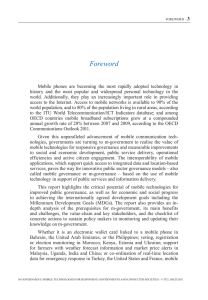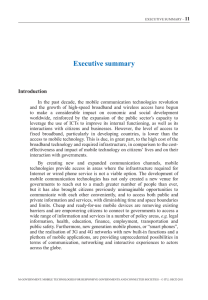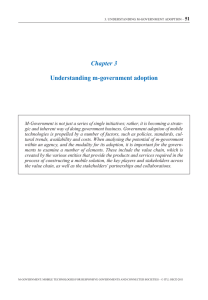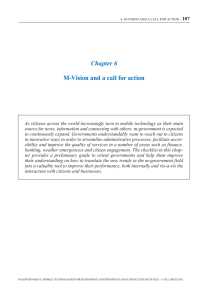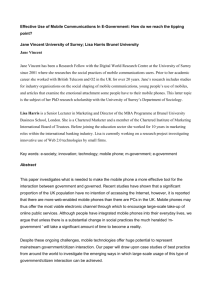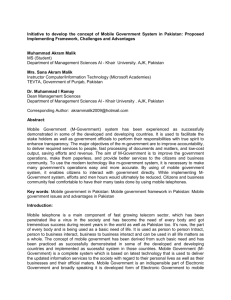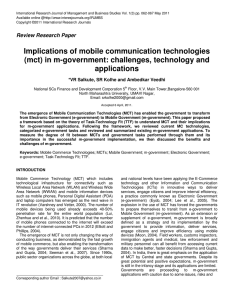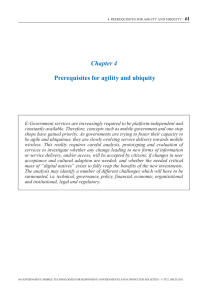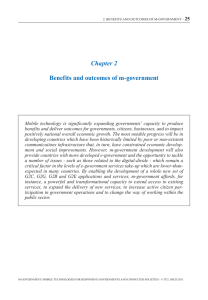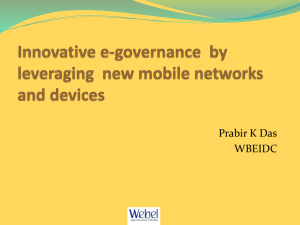Chapter 1 Towards the next generation of public services 15
advertisement
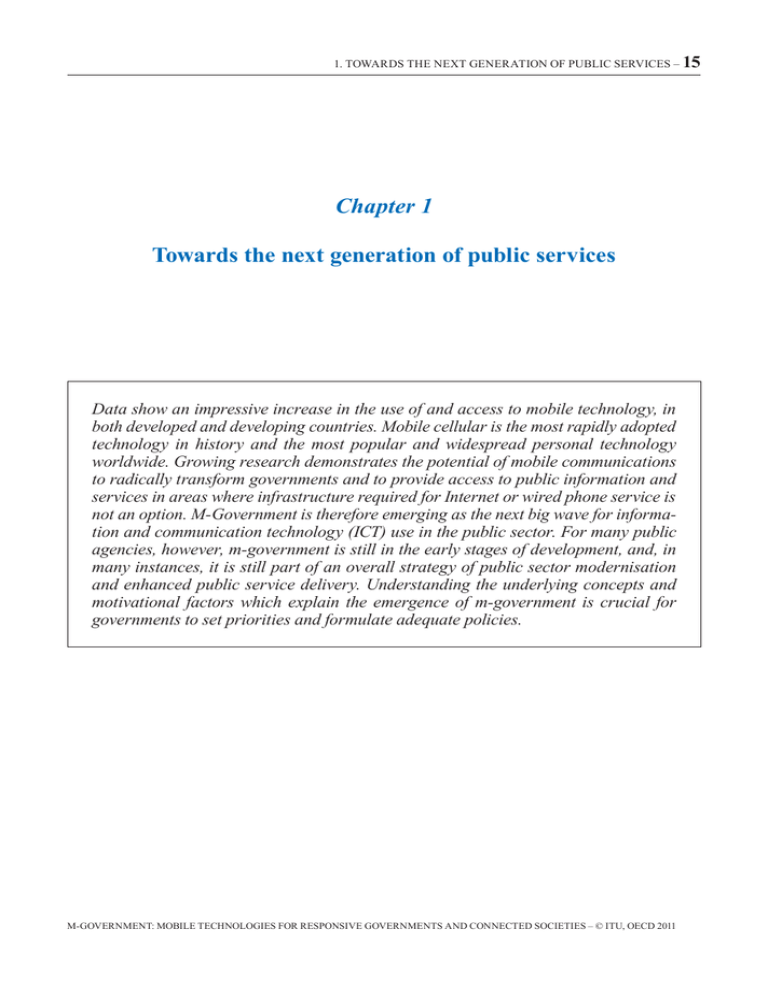
1. TOWARDS THE NEXT GENERATION OF PUBLIC SERVICES – 15 Chapter 1 Towards the next generation of public services Data show an impressive increase in the use of and access to mobile technology, in both developed and developing countries. Mobile cellular is the most rapidly adopted technology in history and the most popular and widespread personal technology worldwide. Growing research demonstrates the potential of mobile communications to radically transform governments and to provide access to public information and services in areas where infrastructure required for Internet or wired phone service is not an option. M-Government is therefore emerging as the next big wave for information and communication technology (ICT) use in the public sector. For many public agencies, however, m-government is still in the early stages of development, and, in many instances, it is still part of an overall strategy of public sector modernisation and enhanced public service delivery. Understanding the underlying concepts and motivational factors which explain the emergence of m-government is crucial for governments to set priorities and formulate adequate policies. M-GOVERNMENT: MOBILE TECHNOLOGIES FOR RESPONSIVE GOVERNMENTS AND CONNECTED SOCIETIES – © ITU, OECD 2011 16 – 1. TOWARDS THE NEXT GENERATION OF PUBLIC SERVICES From e-government to m-government The strategic importance of mobile technologies is becoming more evident, as the wireless and mobile technology explosion increasingly affects how public institutions function and deliver services in both developing and developed countries. “Enabled mobility” offers new opportunities to provide more responsive public services through mobile applications and solutions. Just as the decision to embark on electronic government (e-government) was an important step taken decades ago by many governments worldwide, the adoption of mobile government (m-government) to support and enhance government performance and a more connected society is now inevitable. M-Government is emerging as the next big wave for information and communication technology (ICT) use in the public sector.1 Growing research demonstrates the potential of mobile communications to radically transform government, providing access in areas where infrastructure required for Internet or wired phone service is not an option. Mobile devices’ lower costs and ease of use are removing barriers and empowering citizens to quickly and efficiently connect to government for health, education, employment, public safety, financial, transportation, legal and other services. As such, mobile government can help improve social and economic conditions worldwide and it can play an important role in supporting the achievement of the Millennium Development Goals (MDGs). Recognising these trends – and the need to establish a sound foundation for the deployment of successful m-government initiatives – the ITU, the DESA and the OECD have prepared this report to: highlight the relevance and value of mobile technologies for economic and social impact; examine key principles for fostering agile and ubiquitous m-government; emphasise the importance of policy and governance models; and assist governments in the process of developing sustainable m-government implementation, optimising the range of possibilities for extending the outreach, efficiency and effectiveness of public services. The report is organised into the following sections: Towards the next generation of public services Benefits and outcomes of m-government for citizens, government and business Understanding m-government adoption Prerequisites for agility and ubiquity Technology options for mobile solutions M-vision and a call for action M-GOVERNMENT: MOBILE TECHNOLOGIES FOR RESPONSIVE GOVERNMENTS AND CONNECTED SOCIETIES – © ITU, OECD 2011 1. TOWARDS THE NEXT GENERATION OF PUBLIC SERVICES – 17 References Annex A: Compendium of m-government projects Growth of mobile technologies Research demonstrates a dramatic increase in the use of and access to mobile technology, in both developed and developing countries. By the end of 2010, there were an estimated 5.3 billion mobile cellular phone subscribers, including 940 million subscriptions to 3G services. Ninety percent of the world population, and 80% of the population living in rural areas, has access to mobile networks.2 In many developing countries, fixed telephone lines are largely limited to urban areas, but more than half of rural households have a mobile telephone. Globally, mobile cellular is the most rapidly adopted technology in history and the most popular and widespread personal technology worldwide. Figure 1.1 shows ICT growth over the past decade. In 1998, global mobile penetration was about 5%. In 2008, it was more than 50%. By 2018, the number of mobile subscriptions is expected to be almost the same as the number of global citizens. Figure 1.2 illustrates a compelling perspective on the progression of mobile penetration, networks, speed and other indicators. Mobile technology is becoming an affordable tool to fill in the digital gap between developed and developing countries, especially with the rapidly declining price of mobile products. Emerging and less developed countries have already demonstrated that they are capable of narrowing the digital gap by investing in websites and web portals – and by establishing telecenters, Figure 1.1. Global ICT developments, 2000-2010* Per 100 inhabitants 100 90 Mobile cellular telephone subscriptions 80 Internet users 70 Fixed telephone lines 60 Mobile broadband subscriptions 50 Fixed broadband subscriptions 40 30 20 10 0 2000 2001 2002 2003 2004 2005 2006 2007 2008 2009 2010* *Estimates Source: ITU World Telecommunication/ICT Indicators database. M-GOVERNMENT: MOBILE TECHNOLOGIES FOR RESPONSIVE GOVERNMENTS AND CONNECTED SOCIETIES – © ITU, OECD 2011 18 – 1. TOWARDS THE NEXT GENERATION OF PUBLIC SERVICES kiosks, community centers and other similar outlets to increase access to the Internet. Similarly, they are adopting the use of mobile technology at a fast rate. The significant worldwide increase in governments’ use of mobile technology to communicate with citizens – by simple SMS, alert notification or full-fledged mobile service – will trigger the need to develop more mobile government services and will provide the private sector with an opportunity to work with governments to create and distribute mobile services. For many public agencies, m-government is in the early stage of development, and, in many instances, it is still part of an overall strategy of public sector modernisation and enhanced public service delivery.3 In this context, providing assistance to governments worldwide in the development of a coherent m-government framework for the public sector is fundamental. Figure 1.2. Key performance metrics Key Performance Metrics 1998 2008 2018 (Estimated) Mobile Penetration – Global 5% 55% 96% High GDP per capita Nations/Total Mobile Subscriber Base 75% 24% 15% Mobile Data Services Revenues as % 4% 19% 40% Networks Primary 1G & 2G Mostly 2.5G & 3G Mostly 5G & 6G 3G+ Penetration 0% 18% 90% Network Speeds < 50kbps Up to 2Mbps Up to 1Gbps Devices ASP USD 200 USD 130 < USD 20 < 1% 10% 40% 2 hours 2.5 hours 24 hours Smartphone Penetration Average Battery Life Source: Sharma, C. (2008), Mobile Services Evolution 2008-2018, Bellagio, Italy, 13 July-1 August. Underlying concepts and motivational factors The following brief overview is useful for classifying the evolution of government concepts (See Figure 1.3): Government: The means by which national policies are enforced, as well as the mechanism for determining national policies. E-Government: The use of information and communication technologies, particularly the Internet, as a tool to achieve better government.4 M-Government: An extension or evolution of e-government through utilisation of mobile technologies for public service delivery. M-GOVERNMENT: MOBILE TECHNOLOGIES FOR RESPONSIVE GOVERNMENTS AND CONNECTED SOCIETIES – © ITU, OECD 2011 1. TOWARDS THE NEXT GENERATION OF PUBLIC SERVICES – 19 Figure 1.3. Overview of conventional, electronic, and mobile government concepts C-Government Item Principles Service time Service space Service form E-Government M-Government r #VSFBVDSBUJD1SPDFTT QIPOFGBY r 1SPDFTTSFFOHJOFFSJOHVTJOH*5 1$*OUFSOFU r 4FBNMFTTJOUFHSBUJPOBOEMJOLBHF XJSFMFTTEFWJDFT rIPVSTBEBZEBZTBXFFL r IPVSTBEBZ EBZTBXFFL r IPVSTBEBZEBZTOPOTUPQ r *OQFSTPOWJTJUGBYQIPOF r $VTUPNFSTIPNFBOEPîDF VTJOHUIF*OUFSOFU r $VTUPNFSTMPDBUJPOBOEQIZTJDBM QMBDF r 4FWFSBMWJTJUTUPPîDFT r .VMUJDMJDLTUPXFC QPSUBMT r 0OFUJNFBDDFTTUPOFFEFETFSWJDF Source: Oui-Suk, Uhm (2010), Introduction of m.Government & IT Convergence Technology, KAIST Institute for IT Convergence. There are some fundamental differences between e- and m-government service delivery. E-government involves the electronic provision of information to geographically diverse but technologically homogenous ICTs (such as personal computers or information kiosks). In contrast, m-government involves interaction in which the use contexts are unknown, where accessing government services might be one of several activities being undertaken, and where the physical constraints of interacting with mobile devices limit the amount and type of information that might be located and accessed.5 These differences pose challenges for both implementation and acceptance of m-government. One of the most important questions with respect to developing technology for m-government is: will e-government as we know it now be replaced by m-government as the dominant mode, or will m-government be just another access channel to public administration? In view of developments around the interaction between mobile state administrations, mobile citizens, and mobile public officials, there is no doubt that the transition from e-government to m-government is not only a matter of a shift in the ICT technologies that are applied, but a more fundamental change.6 Such a fundamental change may lead to a different relationship between the mobile state and the mobile citizen, and between the mobile state and the mobile public official, as well as the growth of a different relationship between the citizen and the public official. While there are a number of reasons for the emergence of m-government solutions, the main factors are: wider acceptance of these technologies by the public sector; penetration of mobile devices; M-GOVERNMENT: MOBILE TECHNOLOGIES FOR RESPONSIVE GOVERNMENTS AND CONNECTED SOCIETIES – © ITU, OECD 2011 20 – 1. TOWARDS THE NEXT GENERATION OF PUBLIC SERVICES ease of use for citizens; easier interoperability; the fact it can bring government closer to citizens, and the fact that m-government services are cheaper than computer-based services. Motivational factors are: Better service accessibility – M-government provides an additional communication channel for users to access government services. This can attract more users to access government services using alternative channels that are more convenient, especially for people who are located in geographically remote areas or who are physically disadvantaged. Better service availability – Like many m-business service models, certain m-government services can be automated to provide 24/7 availability, e.g. general information retrieval or certain transaction processing. Better service responsiveness – Because certain m-government services can be automated, users can access these services with virtually no waiting time, whereas completing the same transaction using conventional approaches (such as telephone calls or in-person visits) can take longer. Better service quality and efficiency – Success in building interest, enthusiasm and capacity of socially marginalised communities to interact and communicate via online technologies contributes to m-government’s success in achieving efficiency gains and improving services. Service scalability – The advantage of scalability is that the provision of m-government services has a far lower cost in comparison to traditional service delivery (e.g. printing materials, especially in regions that have higher population density). Efficiency and effectiveness are improved. Flexibility and scalability can be maintained because functional components can use a set of common interfaces to communicate with each other. Better stakeholder participation – M-Government services, optimised by smartphones, allow citizens and businesses to take advantage of the Internet to access government services, resulting in better perception and higher participation. Integration, communication and interaction – Using information technology allows better integration of functional departments in government processes, and increases customer satisfaction with service delivery across both traditional and electronic channels. The additional electronic communication channel gives governments the opportunity to interact with specific groups of users who otherwise may not be reached through conventional communication M-GOVERNMENT: MOBILE TECHNOLOGIES FOR RESPONSIVE GOVERNMENTS AND CONNECTED SOCIETIES – © ITU, OECD 2011 1. TOWARDS THE NEXT GENERATION OF PUBLIC SERVICES – 21 approaches. However, as m-government services are typically designed in a way that requires a considerable amount of human-computer interaction (as citizens operate the services), it may be more difficult for staff to perform maintenance and administration tasks. Reduced costs (fixed and operational) – One of the major benefits to government agencies is the flexibility m-government allows to enable information storage and presentation. This may lead to far lower operating and maintenance costs, compared to printing all materials. Altering, correcting or updating content can be completed online without incurring costs for re-printing, waste disposal and re-delivery. Better image and perception – Research suggests7 that using online or mobile channels to interact with citizens and engage them in decision making has a positive impact on trust, as well as public perceptions of government responsiveness. In addition, the use of mobile channels can lead to increased citizen participation, which can in turn make it easier to design and implement policies that lead to better outcomes. Therefore, m-government services may result in an improved image of government operations, so political decisions may push forward the adoption of m-government services to showcase these factors and to create a more positive international image. Policy formulation and priority setting Policy formulation should take into consideration the following key features of the next generation of public services:8 Citizen centric: Most governments’ work is still not geared to look at policy making from the citizen perspective. Changing governments’ perspective will require real changes in thinking, as well as structure of governance. Restructured government: Governments should move towards more cooperative models of service and policy design and delivery (i.e. adopting a whole-of-government approach, and engaging appropriate players, stakeholders and public agencies). Participatory, measurable and transparent: Citizens are increasingly becoming more aware of the work of government and, in some developed countries, have also started participating in policy making. Transparency and citizens’ ability to measure the outcomes and impact of government programmes, and to participate in their development, will be key features of next generation public services. In the aftermath of the economic and financial crisis, governments need to provide better public services with fewer resources.9 Each of these priorities works towards that goal: providing new and better ways to engage with M-GOVERNMENT: MOBILE TECHNOLOGIES FOR RESPONSIVE GOVERNMENTS AND CONNECTED SOCIETIES – © ITU, OECD 2011 22 – 1. TOWARDS THE NEXT GENERATION OF PUBLIC SERVICES citizens. The availability of innovative mobile technologies – together with more open specifications which allow for greater sharing, re-use and interoperability, and the possibility of counting on the future market trends – reinforce the strong role for mobile services in the government’s pursuit of the next generation of public services. Notes 1. Kushchu, I. (2007), Mobile Government: An Emerging Direction in E.Government, IGI Publishing, Hershey, PA, USA. 2. ITU World Telecommunication/ICT Indicators database. 3. Antovski, L. and M. Gusev (2005), M.Government Framework, Mobile Government Consortium International. 4. OECD (2003), The E-Government Imperative. 5. Carroll, J. (2006), What’s in It for Me? Taking M.Government to the People, University of Melbourne, Australia, 19th Bled eConference, 2006. 6. Snellen, I. and M. Thaens (2008), From e.government to m.government: towards a new paradigm in public administration?, Erasmus University. 7. United Nations Department of Economic and Social Affairs, E.Government Survey 2010, (New York: United Nations, 2010). 8. Ward, Carl, Cloud Computing, Mobile Governance and Web 2.0 technologies, Conference Proceedings Report, The Society for Promotion of eǦGovernance, 2009. 9. European Commission, COM (2010) 743, The European eGovernment Action Plan 2011-2015, (Brussels, 15 December, 2010). M-GOVERNMENT: MOBILE TECHNOLOGIES FOR RESPONSIVE GOVERNMENTS AND CONNECTED SOCIETIES – © ITU, OECD 2011 1. TOWARDS THE NEXT GENERATION OF PUBLIC SERVICES – 23 Bibliography Antovski, L. and M. Gusev (2005), “M.Government Framework”, paper presented at the Mobile Government Consortium Internationa, Brighton, 10-12 July. Carroll, J. (2006), “What’s in It for Me? Taking M.Government to the People”, paper presented at the 19th Bled eConference, Bled, 5 June. European Commission, COM (2010) 743, “The European eGovernment Action Plan 2011-2015”, Working document, European Commission, Brussels. Kushchu, I. (2007), Mobile Government: An Emerging Direction in E.Government, IGI Publishing, Hershey, PA, USA. OECD (2003), The E-Government Imperative, OECD Publishing, Paris. OECD (2005), E-Government for Better Government, OECD Publishing, Paris. Oui-Suk, U. (2010), “Introduction of m.Government & IT Convergence Technology”, working document, KAIST Institute for IT Convergence, Daejeon, Republic of Korea. Sharma, C. (2008), Mobile Services Evolution 2008-2018, Chetan Sharma Consulting, Issaquah, WA, USA. Snellen, I. and M. Thaens (2008), “From e.government to m.government: towards a new paradigm in public administration?”, Working document, Erasmus University, Rotterdam. Tarek, E. (2007), Emerging Mobile Government Services: Strategies for Success, 20th Bled eConference, Slovenia. United Nations Department of Economic and Social Affairs (2010), “E.Government Survey 2010”, New York: United Nations. Ward, K. (2009), Cloud Computing, Mobile Governance and Web 2.0 technologies, Conference Proceedings Report, The Society for Promotion of eǦGovernance. M-GOVERNMENT: MOBILE TECHNOLOGIES FOR RESPONSIVE GOVERNMENTS AND CONNECTED SOCIETIES – © ITU, OECD 2011
